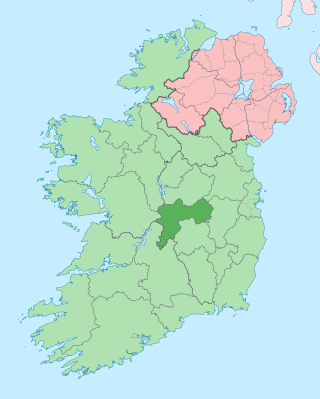
The counties of Ireland are historic administrative divisions of the island. They began as Norman structures, and as the powers exercised by the Cambro-Norman barons and the Old English nobility waned over time, new offices of political control came to be established at a county level. The number of counties varied depending on the time period, however thirty-two is the traditionally accepted and used number.

County Laois is a county in Ireland. It is part of the Eastern and Midland Region and in the province of Leinster. It was known as Queen's County from 1556 to 1922. The modern county takes its name from Loígis, a medieval kingdom. Historically, it has also been known as County Leix.

Thomas Radclyffe, 3rd Earl of Sussex KG, was Lord Deputy of Ireland during the Tudor period of English history, and a leading courtier during the reign of Elizabeth I.

County Offaly is a county in Ireland. It is part of the Eastern and Midland Region and the province of Leinster. It is named after the ancient Kingdom of Uí Failghe. It was formerly known as King's County, in honour of Philip II of Spain. Offaly County Council is the local authority for the county. The county population was 82,668 at the 2022 census.

The Tudor conquestof Ireland took place during the 16th century under the Tudor dynasty, which ruled the Kingdom of England. The Anglo-Normans had conquered swathes of Ireland in the late 12th century, bringing it under English rule. In the 14th century, the effective area of English rule shrank markedly, and from then most of Ireland was held by native Gaelic chiefdoms. Following a failed rebellion by the Earl of Kildare in the 1530s, the English Crown set about restoring its authority. Henry VIII of England was made "King of Ireland" by the Crown of Ireland Act 1542. The conquest involved assimilating the Gaelic nobility by way of "surrender and regrant"; the confiscation and colonization ('plantation') of lands with settlers from Britain; imposing English law and language; banning Catholicism, dissolving the monasteries and making Anglican Protestantism the state religion.

Plantations in 16th- and 17th-century Ireland involved the confiscation of Irish-owned land by the English Crown and the colonisation of this land with settlers from Great Britain. The Crown saw the plantations as a means of controlling, anglicising and 'civilising' Gaelic Ireland. The main plantations took place from the 1550s to the 1620s, the biggest of which was the plantation of Ulster. The plantations led to the founding of many towns, massive demographic, cultural and economic changes, changes in land ownership and the landscape, and also to centuries of ethnic and sectarian conflict. They took place before and during the earliest English colonisation of the Americas, and a group known as the West Country Men were involved in both Irish and American colonization.

In the history of colonialism, a plantation was a form of colonization where settlers would establish permanent or semi-permanent colonial settlements in a new region. The term first appeared in the 1580s in the English language to describe the process of colonization before being also used to refer to a colony by the 1610s. By the 1710s, the word was also being used to describe large farms where cash crop goods were produced, typically in tropical regions.
The kingdom of Uí Fháilghe, Uí Failge or Uíbh Fhailí, was a Gaelic-Irish kingdom which existed to 1550, the name of which is preserved in the name of County Offaly, Ireland.
Sir Rory O'Moore, also known Sir Roger O'Moore or O'More or Sir Roger Moore, was an Irish landowner, and is most notable for being one of the four principal organisers of the Irish Rebellion of 1641.

Rory O'More, also known as Rory Oge O'More, was an Irish noble of the O'More clan. As Lord of Laois, he rebelled against the English Tudor forces.
Events from the year 1556 in Ireland.

The Treason Act 1554 was an Act of the Parliament of England. It is not to be confused with two other Acts about treason passed in the same year, 1 & 2 Ph. & M. cc. 9 and 11.

The English overseas possessions, also known as the English colonial empire, comprised a variety of overseas territories that were colonised, conquered, or otherwise acquired by the former Kingdom of England during the centuries before the Acts of Union of 1707 between the Kingdom of England and the Kingdom of Scotland created the Kingdom of Great Britain. The many English possessions then became the foundation of the British Empire and its fast-growing naval and mercantile power, which until then had yet to overtake those of the Dutch Republic, the Kingdom of Portugal, and the Crown of Castile.

Upper Ossory was an administrative barony in the south and west of Queen's County in Ireland. In late Gaelic Ireland it was the túath of the Mac Giolla Phádraig (Fitzpatrick) family and a surviving remnant of the once larger kingdom of Ossory. The northernmost part of the Diocese of Ossory and medieval County Kilkenny, it was transferred to the newly created Queen's County, now known as County Laois, in 1600. In the 1840s its three component cantreds, Clarmallagh, Clandonagh, and Upperwoods, were promoted to barony status, thereby superseding Upper Ossory.

The Statute Law Revision Act 1962 is an Act of the Oireachtas.
Events from the year 1557 in Ireland.

Gallen Abbey or Gallen Priory is a medieval monastery and National Monument located in County Offaly, Ireland.

An Act for the division of Meath into two shires was an act of the Parliament of Ireland passed in 1542 which resulted in the division of County Meath, shired in 1297, into the counties of Meath and Westmeath. The Act commenced on Saint Catherine's Day in 1542 and remains in effect.















